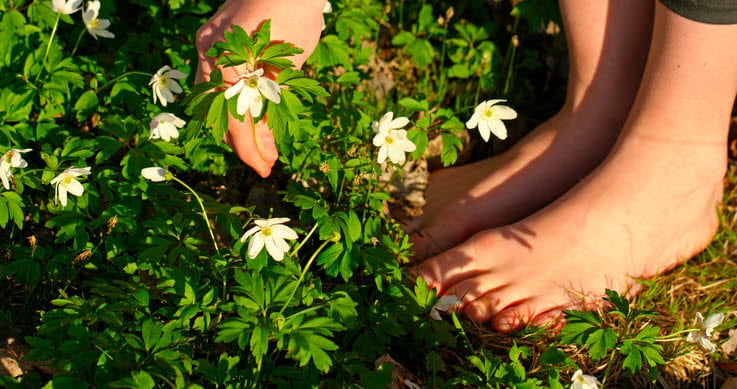Browning MHEM, Rigolon A. Could nature help children rise out of poverty? Green space and future earnings from a cohort in ten U.S. cities. Environ Res. 2019;176:108449. doi:10.1016/j.envres.2019.04.016
Centrum för arbets- och miljömedicin. Miljöhälsorapport 2017. Stockholms Län. Stockholms läns landsting; 2017.
Cronin-de-Chavez A, Islam S, McEachan RRC. Not a level playing field: A qualitative study exploring structural, community and individual determinants of greenspace use amongst low-income multi-ethnic families. Health Place. 2019;56:118-126. doi:10.1016/j.healthplace.2019.01.018
Dadvand P, Gascon M, Markevych I. Green Spaces and Child Health and Development. Biodiversity and Health in the Face of Climate Change: Springer, Cham; 2019. sid. 121-130.
Engemann K, Pedersen CB, Arge L, et al. Residential green space in childhood is associated with lower risk of psychiatric disorders from adolescence into adulthood. Proceedings of the national academy of sciences. 2019;116(11):5188-93. doi:10.1073/pnas.1807504116
Ferrante G, Asta F, Cilluffo G, et al. The effect of residential urban greenness on allergic respiratory diseases in youth: A narrative review. World Allergy Organization Journal. 2020;13(1). doi:10.1016/j.waojou.2019.100096
Folkhälsomyndigheten. Övervikt och fetma bland skolbarn 11–15 år fortsätter öka. https://www.folkhalsomyndigheten.se/contentassets/f140506da2394022aa07c11e5234df03/20020overvikt-fetma-barn-forts-oka.pdf (PDF) (internet 2024-01-24).
Fraser SD, Lock K. Cycling for transport and public health: a systematic review of the effect of the environment on cycling. Eur J Public Health. 2011;21(6):738-743. doi:10.1093/eurpub/ckq145
Hartley K, Ryan P, Brokamp C, et al. Effect of greenness on asthma in children: A systematic review. Public health nursing. 2020;37(3):453-60. doi:10.1111/phn.12701
Hughes J, Rogerson M, Barton J, et al. Age and connection to nature: when is engagement critical? Frontiers in Ecology and the Environment. 2019;17(5):265-9. doi:10.1002/fee.2035
Islam MZ, Johnston J, Sly PD. Green space and early childhood development: a systematic review. Rev Environ Health. 2020;35(2):189-200. doi:10.1515/reveh-2019-0046
Krishnamurthy S. Reclaiming spaces: child inclusive urban design. Cities & Health, 2019, 3:1-2, 86-98, doi:10.1080/23748834.2019.15863275.
Kruize H, van der Vliet N, Staatsen B, et al. Urban Green Space: Creating a Triple Win for Environmental Sustainability, Health, and Health Equity through Behavior Change. Int J Environ Res Public Health. 2019;16(22):4403. Published 2019 Nov 11. doi:10.3390/ijerph16224403
Kuo M, Barnes M, Jordan C. Do Experiences With Nature Promote Learning? Converging Evidence of a Cause-and-Effect Relationship. Front Psychol. 2019;10:305. Published 2019 Feb 19. doi:10.3389/fpsyg.2019.00305
Lambert A, Vlaar J, Herrington S, Brussoni M. What Is the Relationship between the Neighbourhood Built Environment and Time Spent in Outdoor Play? A Systematic Review. Int J Environ Res Public Health. 2019;16(20):3840. 2019 Oct 11. doi:10.3390/ijerph16203840
Lee M, Kim S, Ha M. Community greenness and neurobehavioral health in children and adolescents. Sci Total Environ. 2019;672:381-388. doi:10.1016/j.scitotenv.2019.03.454
Liao J, Zhang B, Xia W, et al. Residential exposure to green space and early childhood neurodevelopment. Environ Int. 2019;128:70-76. doi:10.1016/j.envint.2019.03.070
Mao Q, Wang L, Guo Q, et al. Evaluating Cultural Ecosystem Services of Urban Residential Green Spaces From the Perspective of Residents’ Satisfaction With Green Space. Front Public Health. 2020;8:226. Published 2020 Jul 17. doi:10.3389/fpubh.2020.00226
McCormick R. Does Access to Green Space Impact the Mental Well-being of Children: A Systematic Review. J Pediatr Nurs. 2017;37:3-7. doi:10.1016/j.pedn.2017.08.027
Mennis J, Mason M, Ambrus A. Urban greenspace is associated with reduced psychological stress among adolescents: A Geographic Ecological Momentary Assessment (GEMA) analysis of activity space. Landscape and Urban Planning. 2018;174:1-9. doi:10.1016/j.landurbplan.2018.02.008
Putra IGNE, Astell-Burt T, Cliff DP, Vella SA, John EE, Feng X. The Relationship Between Green Space and Prosocial Behaviour Among Children and Adolescents: A Systematic Review. Front Psychol. 2020;11:859. Published 2020 Apr 30. doi:10.3389/fpsyg.2020.00859
Ribeiro AI, Tavares C, Guttentag A, Barros H. Association between neighbourhood green space and biological markers in school-aged children. Findings from the Generation XXI birth cohort. Environ Int. 2019;132:105070. doi:10.1016/j.envint.2019.105070
Roe J, Aspinall PA, Ward Thompson C. Understanding relationships between health, ethnicity, place and the role of urban green space in deprived urban communities. International journal of environmental research and public health. 2016;13(7):681.
Rufo JC, Paciência I, Ribeiro AI. Green Environments and Allergic Diseases in Children: a Scoping Review. Current Epidemiology Reports. 2019;6(4):442-8. doi:10.1007/s40471-019-00218-0
SCB. Fler barn bor i storstäder i framtiden. https://www.scb.se/hitta-statistik/artiklar/2019/fler-barn-bor-i-storstader-i-framtiden. (Internet 2024-01-24)
Zhou Y, Buck C, Maier W, et al. Built Environment and Childhood Weight Status: A Multi-Level Study Using Population-Based Data in the City of Hannover, Germany. Int J Environ Res Public Health. 2020;17(8):2694. Published 2020 Apr 14. doi:10.3390/ijerph17082694
